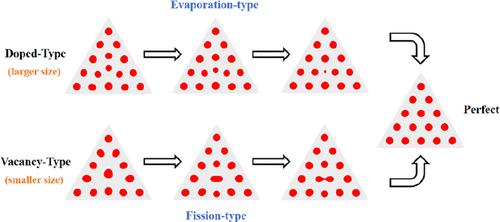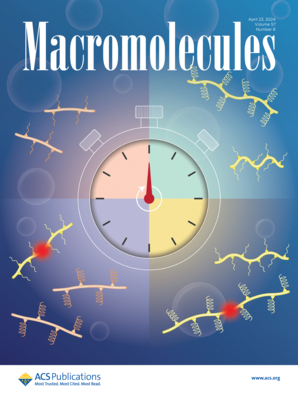Defect Annihilation Mechanisms in Hexagonal Cylinders Formed by Diblock Copolymers under Triangular Confinement
IF 5.1
1区 化学
Q1 POLYMER SCIENCE
引用次数: 0
Abstract
The self-assembly of hexagonal cylinder-forming diblock copolymers under laterally triangular confinement provides a useful method for the fabrication of defect-free hexagonal patterns. However, as the triangular confinement size becomes larger, its confinement effect drops down and thus the occurrence of defects is still inevitable. Here, we first use self-consistent field theory (SCFT) to demonstrate that there always exists a thermodynamically stable perfect hexagonal pattern within the triangle of any size by comparing the free energy of the perfect hexagonal morphology with as many defective morphologies as possible. These metastable defects can be categorized into doped- and vacancy-types. Then, we combine SCFT with the string method to determine the minimum free-energy path (MFEP) for defects to evolve into perfect morphologies, focusing on the influence of two key factors on the stability of defects, i.e., the confinement size and the segregation strength χN. The results reveal that the confinement size has an significant effect on the kinetic stability of defects. The defect becomes less stable and easier to annihilate into the perfect equilibrium morphology when the confinement size approaches the most commensurate size. As χN varies, doped-type defects always prefer to annihilate via the evaporation process, while vacancy-type defects tend to annihilate via the fission process at higher χN and the nucleation process at lower χN, respectively. The free-energy barrier of the favorable MFEP for each defect commonly decreases to vanish with decreasing χN, which is consistent with the conclusions in the corresponding bulk system. The dissipative particle dynamics simulations are carried to verify the influence of the triangular size on the stability of defective morphologies.

三角约束下双嵌段共聚物六方柱体的缺陷湮灭机理
在侧向三角形约束下的六方圆柱形二嵌段共聚物的自组装为制造无缺陷的六方图案提供了一种有用的方法。然而,随着三角约束尺寸的增大,其约束效果下降,缺陷的出现仍然是不可避免的。本文首先利用自洽场论(SCFT),通过比较完美六边形形态与尽可能多的缺陷形态的自由能,证明了在任意大小的三角形内总存在一个热力学稳定的完美六边形图案。这些亚稳缺陷可分为掺杂型和空缺型。然后,我们将SCFT与串法相结合,确定缺陷演化为完美形态的最小自由能路径(MFEP),重点研究约束尺寸和偏析强度χN对缺陷稳定性的影响。结果表明,约束尺寸对缺陷的动力学稳定性有显著影响。当约束尺寸接近最合适的尺寸时,缺陷变得不稳定,更容易湮灭到完美的平衡形态。随着χN的变化,掺杂型缺陷总是倾向于通过蒸发过程湮灭,而空缺型缺陷则分别在较高χN和较低χN下倾向于通过裂变过程和成核过程湮灭。各缺陷的有利MFEP的自由能势垒通常随χN的减小而减小至消失,这与相应体体系的结论一致。通过耗散粒子动力学模拟验证了三角形尺寸对缺陷形貌稳定性的影响。
本文章由计算机程序翻译,如有差异,请以英文原文为准。
求助全文
约1分钟内获得全文
求助全文
来源期刊

Macromolecules
工程技术-高分子科学
CiteScore
9.30
自引率
16.40%
发文量
942
审稿时长
2 months
期刊介绍:
Macromolecules publishes original, fundamental, and impactful research on all aspects of polymer science. Topics of interest include synthesis (e.g., controlled polymerizations, polymerization catalysis, post polymerization modification, new monomer structures and polymer architectures, and polymerization mechanisms/kinetics analysis); phase behavior, thermodynamics, dynamic, and ordering/disordering phenomena (e.g., self-assembly, gelation, crystallization, solution/melt/solid-state characteristics); structure and properties (e.g., mechanical and rheological properties, surface/interfacial characteristics, electronic and transport properties); new state of the art characterization (e.g., spectroscopy, scattering, microscopy, rheology), simulation (e.g., Monte Carlo, molecular dynamics, multi-scale/coarse-grained modeling), and theoretical methods. Renewable/sustainable polymers, polymer networks, responsive polymers, electro-, magneto- and opto-active macromolecules, inorganic polymers, charge-transporting polymers (ion-containing, semiconducting, and conducting), nanostructured polymers, and polymer composites are also of interest. Typical papers published in Macromolecules showcase important and innovative concepts, experimental methods/observations, and theoretical/computational approaches that demonstrate a fundamental advance in the understanding of polymers.
 求助内容:
求助内容: 应助结果提醒方式:
应助结果提醒方式:


